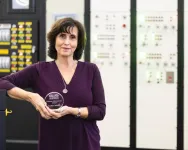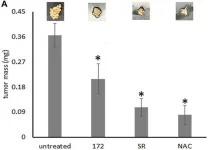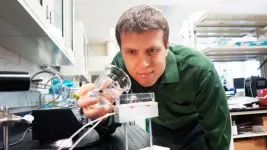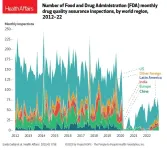(Press-News.org) Embargoed for release until 5:00 p.m. ET on Monday 4 December 2023
Annals of Internal Medicine Tip Sheet
@Annalsofim
Below please find summaries of new articles that will be published in the next issue of Annals of Internal Medicine. The summaries are not intended to substitute for the full articles as a source of information. This information is under strict embargo and by taking it into possession, media representatives are committing to the terms of the embargo not only on their own behalf, but also on behalf of the organization they represent.
----------------------------
1. Most adults eligible for statins for prevention are not using them
Abstract: https://www.acpjournals.org/doi/10.7326/M23-1915
URL goes live when the embargo lifts
Many adults eligible for statin use to prevent cardiovascular disease are not receiving them. A brief research report describing trends in statin prescribing is published in Annals of Internal Medicine.
In 2013, the American Academy of Cardiology/American Heart Association (ACC/AHA) guidelines expanded statin eligibility for primary prevention based on atherosclerotic cardiovascular disease (ASCVD) risk score. Previous studies have not assessed whether the expanded guidelines were associated with changes in statin use in the United States.
Researchers from the University of Pittsburgh and Beth Isreal Deaconess Medical Center studied NHANES (National Health and Nutrition Examination Survey) data for adults aged 20 and older from 1999 to 2018 to describe trends in statin use for primary prevention across indication categories and ASCVD risk scores. They found that although overall statin use for primary prevention has increased over time, it plateaued between 2013 and 2018, with only 35 percent of eligible adults receiving statins. Furthermore, most adults with the strongest guideline recommendations for primary prevention statins are not receiving them, including those with diabetes, extremely high cholesterol, or 10-year risk of cardiovascular disease over 20%. This could be because even though indications for statin use have widened, decision-making complexity has also increased, requiring new multistep risk calculation. This is something that busy clinicians often do not have time to do. According to the authors, these findings suggest that innovative efforts are needed to target patients with the greatest risk.
Media contacts: For an embargoed PDF, please contact Angela Collom at acollom@acponline.org. To speak with the corresponding author, Timothy S. Anderson, MD, MAS, please contact Elaine Vitone at VitoneEG@upmc.edu.
----------------------------
2. Early albuminuria reduction beneficial in patients with CKD and diabetes
Abstract: https://www.acpjournals.org/doi/10.7326/M23-1023
URL goes live when the embargo lifts
Finenerone-induced early albuminuria reduction can lead to tangible benefits for both kidney and cardiovascular health in patients with both chronic kidney disease (CKD) and type two diabetes. The findings from a post hoc analysis of two phase 3 randomized controlled trials are published in Annals of Internal Medicine.
In patients with CKD and type 2 diabetes, finerenone, a nonsteroidal mineralocorticoid receptor antagonist, reduces adverse cardiovascular and renal outcomes. Finerenone also lowers the urine albumin-to-creatinine ratio (UACR). Whether finerenone-induced change in UACR mediates the improved outcomes is unknown.
Researchers from Indiana University School of Medicine and worldwide collaborators, analyzed pooled data from two phase 3 trials of finerenone to quantify the proportion of kidney and cardiovascular risk reductions seen over a 4-year period. Risk reduction was measured by a change in kidney injury indicated by the change in UACR from baseline to month four. The data showed that among patients with CKD and T2D, finerenone-induced improvement in kidney injury seemed to mediate a large proportion of long-term kidney outcomes and a modest proportion of cardiovascular outcomes. Specifically, compared with patients who had less than 30% reduction in UACR, those with 30% or greater reduction in UACR had fewer composite kidney and composite cardiovascular outcome events. According to the authors, these findings emphasize the importance of monitoring UACR after initiating treatment, as it can serve as a valuable surrogate indicator of early treatment efficacy and offer insights into potential long-term kidney and cardiovascular benefits.
Media contacts: For an embargoed PDF, please contact Angela Collom at acollom@acponline.org. To speak with the corresponding author, Rajiv Agarwal, MD, MS, please contact ragarwal@iu.edu
----------------------------
3. CAR-T not cost-effective as a second-line therapy for DLBCL at current prices
Abstract: https://www.acpjournals.org/doi/10.7326/M22-2276
URL goes live when the embargo lifts
Chimeric antigen receptor T-cell therapy (CAR-T) has been proven effective as a second-line treatment for patients with relapsed diffuse large B-cell lymphoma (DLBCL), but the price must be lowered substantially to be considered cost-effective. The findings from a cost-effectiveness analysis are published in Annals of Internal Medicine.
Compared with salvage chemoimmunotherapy with autologous stem cell transplantation (ASCT), the current standard of care for primary-refractory and early-relapsed (high-risk) DLBCL, CAR-T offers superior event-free survival and overall survival. However, at list prices exceeding $400,000 per infusion, cost-effectiveness could be an issue.
Researchers from Dana-Farber Cancer Institute utilized data from several trials including ZUMA-7 and TRANSFORM to determine the cost-effectiveness of second-line CAR-T versus salvage chemoimmunotherapy with ASCT. They found that neither second-line CAR-T treatment with axi-cel nor liso-cel was cost-effective at a willingness-to-pay threshold of $200,000 per quality-adjusted life-year (QALY). Both survival and quality of life improved incrementally, but the data shows that costs of CAR-T must be lowered substantially to enable cost-effectiveness. The authors found that the price of CAR-T would have to be reduced by over $100,000 per patient for it to be cost-effective. Their budget impact analysis found that the US health sector would spend an additional $6.8 billion over 5 years with CAR-T as the new standard of care.
According to the authors, these findings may be relevant to clinic and hospital administrators negotiating reimbursements, pharmaceutical companies balancing costs and profits, private and public insurers navigating negotiations, and policymakers seeking to rein in rising drug prices. The QALY data may also guide clinician–patient treatment discussions.
Media contacts: For an embargoed PDF, please contact Angela Collom at acollom@acponline.org. To speak with the corresponding author, Amar H. Kelkar, MD, MPH, please contact Nicole Oliverio at nicole_oliverio@dfci.harvard.edu.
----------------------------
Also New in this issue:
An Ethical and Financial Obligation for Sickle Cell Disease Gene Therapy in the United States
Austin Wesevich, MD, MPH; Monica E. Peek, MD, MPH, MSc; and Mark J. Ratain, MD
Ideas and Opinions
Abstract: https://www.acpjournals.org/doi/10.7326/M23-2428
END
Most adults eligible for statins for prevention are not using them
2023-12-04
ELSE PRESS RELEASES FROM THIS DATE:
EMBARGOED: CAR-T not cost-effective as second-line therapy for diffuse large B-cell lymphoma at current prices, study finds
2023-12-04
EMBARGOED: December 4, 2023, 5PM EST
Contact:
Nicole Oliverio, Dana-Farber Cancer Institute
617-257-0454, nicole_oliverio@dfci.harvard.edu
CAR-T not cost-effective as second-line therapy for diffuse large B-cell lymphoma at current prices, study finds
RESEARCH SUMMARY
Study Title: Peripheral blood TCR clonotype diversity as an age-associated marker of breast cancer progression
Publication: Annals of Internal Medicine, Click here for link
Dana-Farber Cancer Institute authors include: Amar H. Kelkar, MD, MPH (first author); Edward R. Scheffer Cliff, MBBS, MPH; Caron A. Jacobson, MD; Gregory A. Abel, MD, MPH; Corey Cutler, MD, MPH (senior author); and Robert Redd, MS.
Summary: Chimeric ...
Strange burn: new research identifies unique patterns in Utah wildfires
2023-12-04
For a century fire ecologists have worked to decipher a complex question — what does a “normal'' wildfire year look like in the West? That’s a hard question to answer for many reasons, but new research from a team in the Quinney College of Natural Resources shows that thanks to the state’s unique landscapes, Utah’s wildfire patterns may never fit into what is considered “normal” for other Western states.
Utah landscapes are diverse — from dense forests of pinyon-juniper to scattered patches of sagebrush and grasslands, Utah’s variable topography produces ...
New study identifies the greatest threat to wildlife across North America and Canada: people
2023-12-04
You see posts like these on neighborhood Facebook pages all the time: “An owl just flew into my window and appears stunned! Help!” or “I found a baby squirrel on the ground after the wind storm last night. Who do I call?” The answer is a local wildlife rehabilitation center—licensed individuals and organizations that take in hundreds of thousands of sick and injured wild animals nationwide each year. Wildlife rehabilitators see the highest number and greatest range of species of any government or nonprofit organization in the country, giving them unique insight into animal health—and making them great bellwethers of what’s ...
ORNL engineer Karen White honored with Lifetime Achievement Award
2023-12-04
Oak Ridge National Laboratory’s Karen White, who works in ORNL’s Neutron Science Directorate, has been honored with a Lifetime Achievement Award.
White, who manages the section that provides the machine controls,, computing infrastructure, and protection systems across all neutron science technical areas, received the award during the biennial International Conference on Accelerator and Large Experimental Physics Control Systems, held October 7-13, 2013, in Cape Town, South Africa. The award by ICALEPCS honors and celebrates an individual or individuals ...
Osteopontin induces mitochondrial biogenesis in deadherent cancer cells
2023-12-04
“Here, we study the induction of mitochondrial biogenesis by Osteopontin variants in deadherent breast tumor cells.”
BUFFALO, NY- December 4, 2023 – A new research paper was published in Oncotarget's Volume 14 on December 1, 2023, entitled, “Osteopontin induces mitochondrial biogenesis in deadherent cancer cells.”
Metastasizing cells display a unique metabolism, which is very different from the Warburg effect that arises in primary tumors. Over short time frames, oxidative phosphorylation and ATP generation are prominent. Over longer time frames, mitochondrial biogenesis becomes a pronounced ...
Boiled bubbles jump to carry more heat
2023-12-04
Water is often the go-to resource for heat transfer, being used in large-scale cooling operations like data centers that power the internet and nuclear power plants that power cities. Discovering dynamic phenomena to make water-based heat transfer more energy and cost efficient is the ongoing work of Jonathan Boreyko, associate professor and John R. Jones III Faculty Fellow in mechanical engineering.
Boreyko and his team have published extensively on the topic of water and the way it can move, with members of his Nature-Inspired ...
Increase in child suicide linked to the nation’s opioid crisis
2023-12-04
The rise in child suicides in the U.S. since 2010 was fueled in part by the nation’s opioid crisis, which previous studies found increased rates of child neglect and altered household living arrangements, according to a new RAND Corporation study.
The analysis links the rise is child suicides to the reformulation of prescription opioids to discourage misuse, which led to a steep rise in the use of illicit opioids such as heroin and may have contributed to the growth of illicit opioid markets.
Geographic areas that were more exposed to ...
UCLA scientists receive $9.1 million from the NCI to improve early detection methods for cancer
2023-12-04
Researchers from the UCLA Health Jonsson Comprehensive Cancer Center have received two grants totaling $9.1 million from the National Cancer Institute to advance liquid biopsy technologies for the early detection of cancer, which can significantly improve treatment outcomes and reduce the number of deaths caused by the disease.
A liquid biopsy is a promising non-invasive medical test using a small volume of blood that gives scientists insight into the genetic makeup of tumors. By analyzing these components, researchers can gain valuable information about the genetic mutations, alterations and other molecular changes associated ...
Health Affairs’ December Issue: Global Lessons From COVID-19
2023-12-04
Washington D.C.—The December Health Affairs, a theme issue about the lessons learned around the globe from the COVID-19 pandemic, covers topics including how modeling was used to respond to the pandemic, how health inequities emerged and were addressed, and how countries tried to protect their vulnerable residents. The December issue of Health Affairs was supported by the Robert Wood Johnson Foundation and the Merck Foundation.
There will be a Health Affairs briefing on Tuesday, December 5, from 11:00 a.m. to 2:00 p.m. ET. Register here.
COVID-19, a decline in FDA foreign facility inspections.
At the start of the COVID-19 pandemic, the Food and Drug Administration (FDA) halted ...
BioOne announces Subscribe to Open Pilot
2023-12-04
WASHINGTON D.C. – BioOne, the leading nonprofit aggregator in the biological, ecological, and environmental sciences, today announces a bold plan to offer up to 80 society titles as part of a Subscribe to Open (S2O) pilot beginning in January 2026.
This decision, unanimously endorsed by the BioOne Board of Directors, follows 18 months of careful feasibility analysis and extensive interviews with BioOne’s community of society and library partners in search of an equitable and sustainable path to open.
BioOne will work with its publishing community throughout 2024 to encourage participation in the pilot, ...




